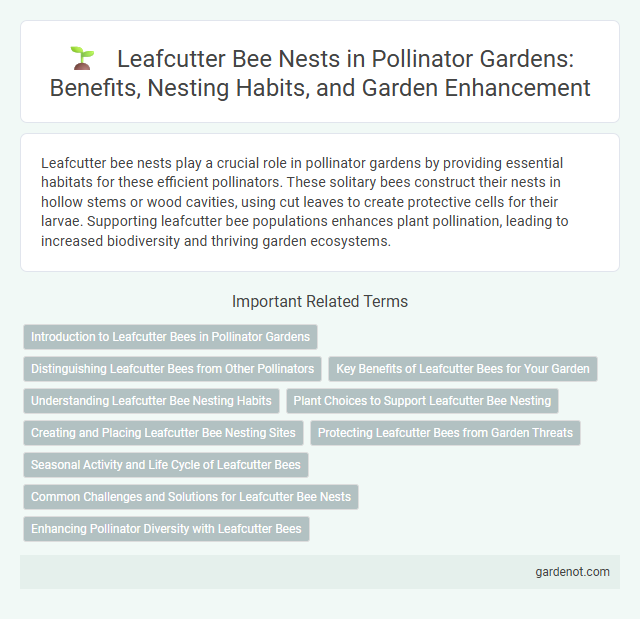Leafcutter bee nests play a crucial role in pollinator gardens by providing essential habitats for these efficient pollinators. These solitary bees construct their nests in hollow stems or wood cavities, using cut leaves to create protective cells for their larvae. Supporting leafcutter bee populations enhances plant pollination, leading to increased biodiversity and thriving garden ecosystems.
Introduction to Leafcutter Bees in Pollinator Gardens
Leafcutter bees (genus Megachile) are essential pollinators frequently found in pollinator gardens, known for their unique behavior of cutting circular leaf pieces to construct their nests. These solitary bees create nests in pre-existing cavities, such as hollow stems or wood holes, contributing significantly to the pollination of wildflowers, fruits, and vegetables. Incorporating leafcutter bees into pollinator gardens enhances biodiversity and supports healthy ecosystem function by promoting effective plant reproduction.
Distinguishing Leafcutter Bees from Other Pollinators
Leafcutter bees are distinguished by their unique nesting behavior, using neatly cut leaf pieces to construct individual cells within tubular cavities. Unlike honeybees or bumblebees, they do not form large colonies but instead nest solitarily in hollow stems, wood borings, or artificial bee houses. Their robust mandibles enable precise leaf cutting, a key identifying trait critical for effective pollination in garden ecosystems.
Key Benefits of Leafcutter Bees for Your Garden
Leafcutter bees enhance garden health by efficiently pollinating a variety of flowering plants, significantly boosting fruit and vegetable yields. Their solitary nesting habits reduce competition and disease transmission, promoting a balanced ecosystem. These bees also support biodiversity by encouraging native plant growth and providing natural pest control through increased pollination activity.
Understanding Leafcutter Bee Nesting Habits
Leafcutter bees create nests by cutting circular pieces from leaves, which they use to build protective cells for their larvae inside hollow stems or wood cavities. These solitary bees prefer nesting sites with easy access to fresh foliage and pollen, making gardens with diverse native plants ideal habitats. Understanding their nesting habits helps gardeners provide suitable materials and conditions to support leafcutter bee populations, enhancing pollination and ecosystem health.
Plant Choices to Support Leafcutter Bee Nesting
Choosing plants with sturdy stems such as elderberry, rose, or sumac provides ideal nesting sites for leafcutter bees, which use these stems to create secure tubes for their larvae. Native wildflowers like goldenrod and purple coneflower supply essential pollen resources that sustain leafcutter bees during their active months. Incorporating a mix of early and late-blooming plants ensures continuous foraging opportunities, directly supporting the successful development of leafcutter bee nests.
Creating and Placing Leafcutter Bee Nesting Sites
Creating and placing leafcutter bee nesting sites involves providing small, tube-like cavities made from natural materials such as hollow stems, wood blocks with drilled holes, or paper tubes. Position these nests in sunny, sheltered locations, ideally facing south or southeast, to maximize warmth and protect from wind and rain. Regularly maintain and clean nesting materials to reduce parasitic infestations and promote healthy pollinator populations.
Protecting Leafcutter Bees from Garden Threats
Leafcutter bee nests provide essential shelter, promoting the survival of these vital pollinators in your garden. To protect leafcutter bees from threats such as pesticides, predatory insects, and habitat loss, use organic gardening methods and maintain diverse native plants for food and shelter. Secure nesting materials and avoid disturbing nests to ensure healthy leafcutter bee populations that enhance pollination and garden productivity.
Seasonal Activity and Life Cycle of Leafcutter Bees
Leafcutter bees exhibit peak activity during late spring and early summer, aligning with the blooming period of many pollinator plants. Females construct nests by cutting circular leaf pieces, forming individual brood cells where eggs are laid and provisioned with pollen and nectar. The complete life cycle spans several weeks, with larvae developing inside sealed cells and adults emerging by late summer to continue pollination activities.
Common Challenges and Solutions for Leafcutter Bee Nests
Leafcutter bee nests often face challenges such as parasitism by kleptoparasitic wasps and fungal infections that can hinder larval development. Installing protective nesting tubes with fine mesh guards can prevent wasps from accessing the nests, while ensuring proper ventilation and dryness reduces fungal growth. Providing a diversity of suitable nesting materials and regularly cleaning the nesting site also supports healthier Leafcutter bee populations.
Enhancing Pollinator Diversity with Leafcutter Bees
Leafcutter bee nests provide crucial habitats that support pollinator diversity by offering secure sites for egg-laying within hollow stems or wood cavities. These solitary bees cut precise leaf pieces to construct protective brood cells, enhancing pollination efficiency in gardens with a variety of flowering plants. Encouraging leafcutter bee nesting increases local biodiversity and promotes robust pollination services critical for ecosystem health.
Leafcutter bee nest Infographic

 gardenot.com
gardenot.com